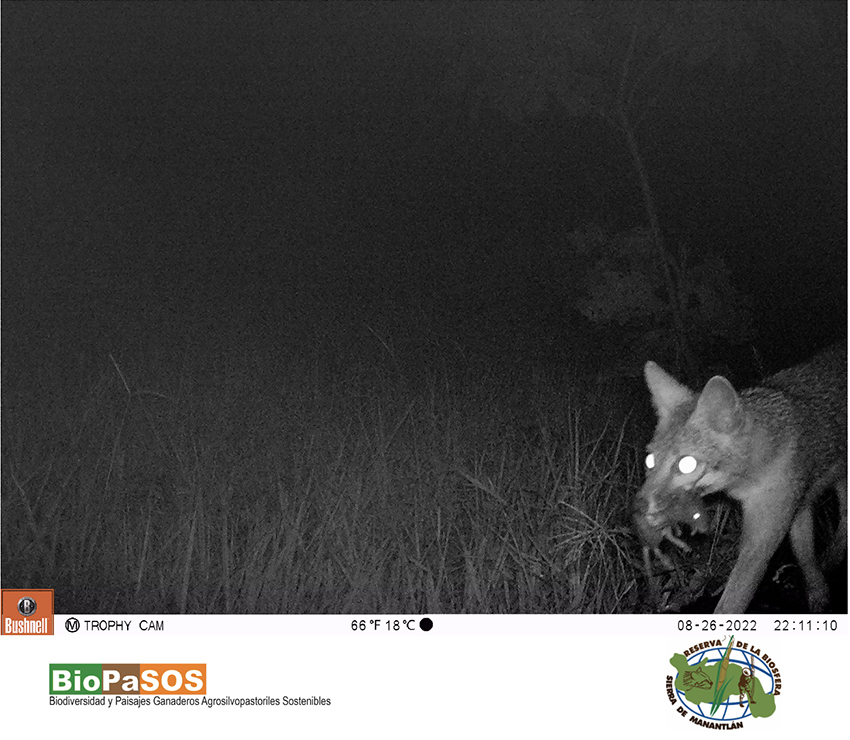Monitoring of wildlife present in livestock landscapes of Jalisco

- · Monitoring is carried out with the objective of making an inventory of the species present in order to determine diversity indicators.
The Biodiversity and Sustainable Agro-silvopastoral Livestock Landscapes project, known as BioPaSOS, in collaboration with the Sierra de Manantlán Biosphere Reserve (RBSM,its Spanish acronym), of the National Commission of Natural Protected Areas (CONANP), and livestock producers in Jalisco, Mexico, are monitoring fauna in order to determine indicators of diversity such as richness, abundance, dominance and equitability present in 16 sampling points, located in areas of the RBSM with livestock activities.
“By monitoring the biological components of cattle ranches with different management conditions within the RBSM area, we aim to analyze the contribution of different land uses to the conservation of wildlife communities," said Juan Edduardo Betanzos, local coordinator of the BioPaSOS project in Jalisco.
The monitoring is being led by RBSM staff, including Fernando Ramón, director of the Reserve; Germán Guzmán and Oscar Manuel Sánchez, technicians of the Natural Protected Area. With support from Daniel Gachuz, from the University of Guadalajara; together with Betanzos and Alejandra Martínez-Salinas, from the BioPaSOS project. In addition, Rodrigo Nuño, from IRNA, through the Mexican Government's Youth Building the Future program, and cooperating producers from the BioPaSOS Field Schools have been involved in the monitoring.
Specifically, monitoring is carried out in the communities of La Yerbabuena, in the municipality of Autlán de Navarro, and the indigenous community of Cuzalapa, in the municipality of Cuautitlán de García Barragán.
There are 16 camera traps in productive sites where silvo-pastoral systems of live fences and scattered trees in pastures have been implemented, in addition to four control sites (conserved sites).
"The study will identify the diversity of mammal and fauna species present in livestock landscapes and recognize the importance of these areas for the conservation of biodiversity, as well as for the generation of information that will allow decisions to be made on the establishment of different silvo-pastoral arrangements and the implementation of good livestock practices," Betanzos said.
During the verification of the operation of the camera traps, carried out two weeks after their establishment, the presence of some species such as: ocelot (Leopardus pardalis), lesser black eagle (Buteogallus anthracinus), coyote (Canis latrans), gray fox (Urocyon cinereoargenteus), white-tailed deer (Odocoileus virginianus), among others, was verified.Leopardus pardalis), águila negra menor (Buteogallus anthracinus), coyote (Canis latrans), zorra gris (Urocyon cinereoargenteus), venado cola blanca (Odocoileus virginianus), entre otros.
Project BioPaSOS is implemented by CATIE (Tropical Agricultural Research and Higher Education Center), with the support of the Inter-American Institute for Cooperation on Agriculture (IICA), in coordination with the National Commission for the Knowledge and Use of Biodiversity (CONABIO, its Spanish acronym) and the Ministry of Agriculture and Rural Development (AGRICULTURA), with funding from the International Climate Initiative (IKI) and in alliance with multiple local partners in their territories of intervention.



More information:
Juan Edduardo Betanzos Simon
Local Coordinator in Jalisco
BioPaSOS Project
CATIE
juan.betanzos@catie.ac.cr
Written by::
Karla Salazar Leiva
Communicator
Information Technology and Communication
CATIE



